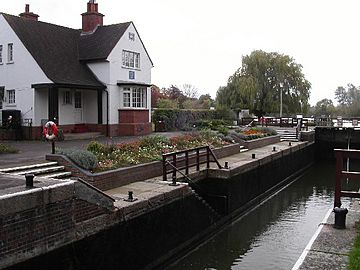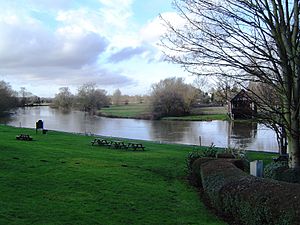Benson Lock facts for kids

The keeper's house and lock at Benson Lock
|
|
| Waterway | River Thames |
|---|---|
| County | Oxfordshire |
| Maintained by | Environment Agency |
| Operation | Hydraulic |
| First built | 1788 |
| Latest built | 1870 |
| Length | 40.56 m (133 ft 1 in) |
| Width | 5.46 m (17 ft 11 in) |
| Fall | 1.87 m (6 ft 2 in) |
| Above sea level | 144' |
| Distance to Teddington Lock |
72 miles |
Benson Lock is a special kind of gate system, called a lock, on the River Thames in England. It's near the village of Benson in Oxfordshire, but on the other side of the river. Locks help boats move up or down a river when the water level changes.
The very first lock built here was in 1788. It was a "pound lock," which means it had gates at both ends to hold a section of water. This first lock was made of wood. Later, in 1870, it was replaced with the stronger stone lock you see today.
Benson Lock is quite far from the next lock downstream, Cleeve Lock. The distance between them is about 6.5 miles (10.4 kilometers). This is the longest stretch between any two locks on the whole River Thames!
Right next to the lock, there's a weir. A weir is like a small dam that controls the water flow. You can walk across the river here using a footbridge over the weir. This bridge replaced an old ferry that used to take people across. The famous Thames Path, a long walking trail, also crosses the river at this spot.
History of Benson Lock
People have known about a weir here since the late 1300s. Back then, there was a mill at a place called "Bensington." A mill uses the power of flowing water to grind grain. The old mill is gone now, but you can still see the island and stream where it once stood, on the Benson side of the river.
Before the modern lock, there was a "flash lock" here. A flash lock was a simple barrier that could be opened quickly to create a rush of water, helping boats pass. The first clear mention of this flash lock was in 1746.
The first proper pound lock was built in 1788. It was made of oak wood. It's interesting to note that special workers, possibly from the Netherlands, were hired for this job. They were paid more than usual because they were experts. The lock was rebuilt with strong stone in 1870, making it much more durable.
Originally, the miller (the person who ran the mill) was supposed to look after the lock. However, records from 1865 mention an empty lock house, suggesting no one was living there. The current house for the lock keeper (the person who operates the lock) was built in 1913.
Getting to Benson Lock
Benson Lock is just a short walk from the village of Benson. You can easily reach it by crossing the weir on the footbridge.
River Journey Above the Lock
As you travel upstream from Benson Lock, you'll find the river passes through a village called Shillingford. Here, the river flows under Shillingford Bridge. This bridge is made of strong stone and brick. It has three main arches over the river and many more arches on the northern side, forming a long pathway. This bridge is considered a historic building.
As you go along, you'll often see the two round-topped hills known as the Wittenham Clumps. They are a famous landmark in the area.
After Shillingford, another river, the River Thame, joins the Thames. The River Thame flows from the direction of Dorchester, which is a short distance north. Small boats can travel on the River Thame as far as Dorchester Bridge.
The Thames Path is a walking trail that crosses the river at Benson Lock. From there, it follows a road in Benson and then goes back along the northern side of the river towards Shillingford. In Shillingford, the path takes a small detour through the town before rejoining the river outside. It continues on the northern bank, crossing the River Thame, until it reaches Little Wittenham Bridge. The path crosses the river again just before Day's Lock.
Images for kids





